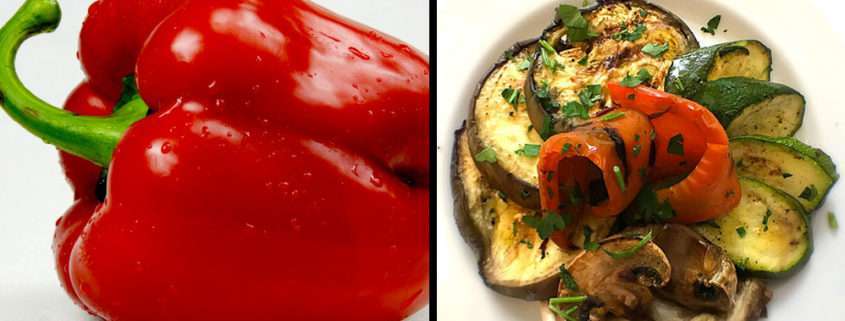The summer season brings with it the promise of upcoming holidays and many types of fresh, tasty and colourful fruit and vegetables. Among the many typical summer vegetables we have peppers, appreciated by many for their particular taste that makes them unique. Those who love this vegetable with its different shape, colour and flavour, and versatile in the kitchen, besides satisfying their palate, have the advantage of enjoying the nutritional and beneficial properties that characterise it.
Depending on the variety we have peppers of different shapes and colours, and according to the maturation we switch from green to colours such as red, yellow, orange and other shades. The shapes range from the more elongated, smaller, characteristic of the so-called “friggitelli”, to the round or quadrangular. Depending on the type of pepper, the taste also varies, which can be delicate, strong or spicy.
Let’s discover together the properties and different ways of cooking this vegetable with its inviting appearance and strong colour.
A vegetable with many properties
First of all, the pepper is rich in water, potassium and carotene, three useful elements for the well-being of the urinary tract. In addition to potassium, it contains other minerals that are precious to the body, such as magnesium, phosphorus, calcium and iron, which it absorbs. Moreover, which is completely unexpected, it contains a high percentage of vitamin C, even higher than that present in citrus fruit. To keep the content of this precious vitamin unchanged in the pepper, it is preferable to eat it raw, diced and seasoned like a crispy salad. It is also important to respect the seasonality, which guarantees the highest nutritional intake. The innumerable properties of vitamin C are well known, which, in addition to preventing colds if taken regularly, together with vitamin A, also contained in peppers, has an antioxidant action that counteracts the harmful effects of the much feared free radicals.
Another ally of the health of our organism contained in this vegetable is capsaicin, which has an antibacterial, anti-diabetic and anticancer action.
Like the aubergine (link sulle melanzane), the pepper also contains a significant amount of fibre that help the intestinal transit and give a feeling of satiety which, associated with the low calorie content, helps to keep weight under control.
Why is the pepper poorly digestible?
Sometimes the pepper is demonized because of its poor digestibility, and in fact it is often avoided or consumed with extreme moderation by those who have digestive disorders. The low digestibility is due to two factors: the presence of cellulose on the skin, not easily digestible, and solanine, a substance that if taken in high doses can become toxic and therefore the human body can refuse even in the digestive phase. A substance also present in eggplants, potatoes and tomatoes, so sometimes the problem can be caused by an accumulation of this substance if you eat at the same time other foods that contain it.
The secret to enjoying this vegetable, which is beautiful to see and good to eat, and to enjoy the beneficial and nutritional properties that characterize it, lies therefore in not abusing its quantity. Also for those who do not digest the peppers but just can not do without them, in addition to eating them in small quantities can increase their digestibility by depriving them of the skin.
Peppers in the kitchen
The ways to prepare this good and healthy vegetable are numerous, and leave room for colourful creative recipes!
To give some examples, we can start with a creamy first course seasoned with pepper pesto, prepared with red peppers, extra virgin olive oil, garlic, pine nuts, basil, almonds and Parmesan cheese. Another delicate first course, which fills without weighing down, consists of tasty baked peppers stuffed with rice, a valid alternative to the classic stuffed tomatoes. The stuffed peppers are traditionally filled with meat and sausage, but you can opt for an appetizing vegetarian variant, which includes a filling of ricotta, eggplant and pine nuts.
As a side dish they are very good grilled and served with garlic, oil and parsley. And what about the famous and essential pepper? An appetizing side dish known and loved throughout Italy, and therefore prepared in a different way from region to region and that can be associated with a meat or fish main course.
We at “Il Piccolo Mondo”, love to delight our customers with a fresh side dish of season that includes courgettes, aubergines, mushrooms and an inviting heart of grilled peppers, to be associated with delicious dishes of our menu of Roman tradition and not only…
We are waiting for you in via Aurora 39, a few steps from via Veneto!
For reservations please contact us at 06 42016034.



